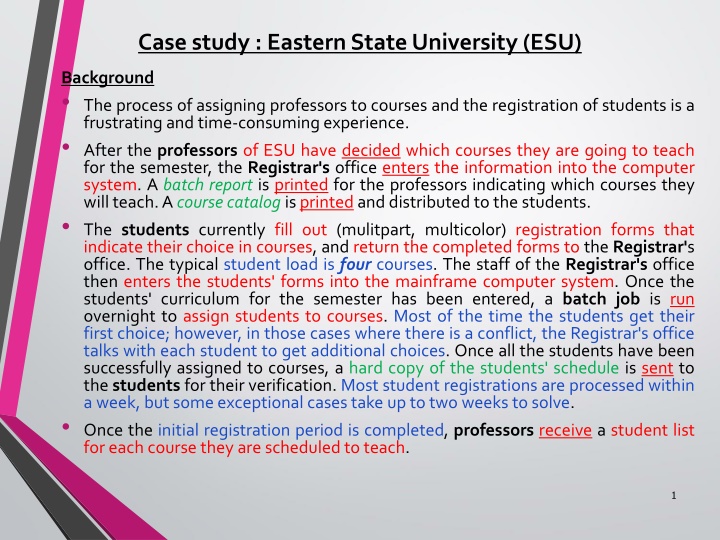
Streamlining Course Registration Process at Eastern State University
Discover how Eastern State University is improving the course registration process for both professors and students, aiming to reduce frustration and save time. Learn about the new system that allows students to select courses, professors to indicate their teaching assignments, and the seamless communication between the registrar's office and students. Find out about the requirements and activities involved in capturing system requirements effectively.
Download Presentation

Please find below an Image/Link to download the presentation.
The content on the website is provided AS IS for your information and personal use only. It may not be sold, licensed, or shared on other websites without obtaining consent from the author. If you encounter any issues during the download, it is possible that the publisher has removed the file from their server.
You are allowed to download the files provided on this website for personal or commercial use, subject to the condition that they are used lawfully. All files are the property of their respective owners.
The content on the website is provided AS IS for your information and personal use only. It may not be sold, licensed, or shared on other websites without obtaining consent from the author.
E N D
Presentation Transcript
Case study : Eastern State University (ESU) Background The process of assigning professors to courses and the registration of students is a frustratingand time-consumingexperience. After the professors of ESU have decided which courses they are going to teach for the semester, the Registrar's office enters the information into the computer system. A batch report is printed for the professors indicating which courses they willteach.Acoursecatalog isprintedand distributed to the students. The students currently fill out (mulitpart, multicolor) registration forms that indicate their choice in courses, and return the completed forms to the Registrar's office. The typical student load is four courses. The staff of the Registrar's office then enters the students' forms into the mainframe computer system. Once the students' curriculum for the semester has been entered, a batch job is run overnight to assign students to courses. Most of the time the students get their first choice; however, in those cases where there is a conflict, the Registrar's office talks with each student to get additional choices. Once all the students have been successfully assigned to courses, a hard copy of the students' schedule is sent to the students for their verification. Most student registrations are processed within a week, but someexceptional casestake up totwo weeks to solve. Once the initial registration period is completed, professors receive a student list for each course they are scheduledto teach. 1
Case study : Eastern State University (ESU) At the beginning of each semester, students may request a course catalog containing a list of course offerings for the semester. Information about each course, such as professor, department, and prerequisites will be included to help students make informed decisions. The new system will allow students to select four course offerings for the coming semester. In addition, each student will indicate two alternative choices in case a course offering becomes filled or canceled. No course offering will have more than ten students or fewer than three students. A course offering with fewer than three students will be canceled. Once the registration process is completed for a student, the registration system sends information to the billing system so the student can be billed for the semester. Professors must be able to access the online system to indicate which courses they will be teaching, and to see which students signed up for their course offerings. For each semester, there is a period of time that students can change their schedule. Students must be able to access the system during this time to add or drop courses. 2
Requirements activities 1. Domain understanding and elicitation. 2. Evaluation and agreement. 3. Specification and Documentation. Capture functional requirements : The straightforward approach to identify system requirements is based on use case Capture non functional requirements : Described in a use case and supplementary requirements. Some nonfunctional requirements are more generic and cannot be connected to a particular use case. 4. Requirements validation. 3
Capturing Requirements as Use-Cases 4
Activity 1 : Finding actors and use Cases Outline who and what (actors) will interacts with the system, and what functionality (use cases) is expected from the system. This activity consists of four steps: Finding actors Finding use cases Briefly describing each use case Describing the use-case model as a whole 5
1.1 Finding Actors The following questions may be used to help identify actors Who is interested in a certain requirement? Where in the organization is the system used? Who will benefit from the use of the system? Who will supply the system with this information, use this information, and remove this information? Who will support and maintain the system? Does the system use an external resource? Does one person play several different roles? Do several people play the same role? Does the system interact with a legacy system? 6
1.1 Finding Actors Actors of the ESU Course Registration System Student wants to register for courses Professor wants to select courses to teach Registrar must create the curriculum and generate a catalog for the semester Registrar must maintain all the information about courses, professors, and students Billing System must receive billing information from the system 7
1.1 Finding Actors A brief description for each actor should be added to the model. The description should identify the role the actor plays while interacting with the system. Student a personwho is registered to take classes at the University Professor a personwho is certified to teach classes at the University Registrar the person who is responsible for the maintenance of the ESU Course Registration System Billing System the external system responsible for student billing 8
1.2 Identifying use cases When the starting point is a business model, we find use case from business model . A use case is suggested for every role of each worker who participates in a business use-case realization and who use the information system. The system analyst identifies the use cases through workshops with the customer and users. The system analyst goes through the actors, one by one, and suggests candidates for use cases for each actor. 9
1.2 Identifying use cases The following questions help identifying use cases for a system: What are the tasks of each actor? Will any actor create, store, change, remove, or read information in the system? Whatuse case will create, store, change, remove, or read this information? Will any actorneed to inform the systemabout sudden, external changes? Does any actorneed to be informed about certain occurrences in the system? Whatuse cases will support and maintain the system? Canallfunctional requirements be performed by the use cases? 10
1.2 Identifying use cases The following needs must be addressed by the system: The Student actor needs to use the system to register for courses. After the course selection process is completed, the Billing System must be supplied with billing information. The Professor actor needs to use the system to select the courses to teach for a semester, and must be able to receive a course roster from the system. The Registrar is responsible for the generation of the course catalog for a semester, and for the maintenance of all information about the curriculum, the students, and the professors needed by the system. 11
1.2 Identifying use cases Use Cases in the ESU Course Registration System Register for courses Select courses to teach Request students list Maintain course information Maintain professor information Maintain student information Create course catalog 12
1.3 Describing each Use Case briefly The brief description of a use case states the purpose of the use case in a few sentences, providing a high-level definition of the functionality provided by the use case. o Example : The brief description of the Register for Courses use case is as follows: This use case is started by the Student. It provides the capability to create, modify, and/or review a student schedule for a specified semester. 13
1.4 Describing the use-case modelas a whole It is not enough to understand each use case in isolation. We also need to see the whole picture. We prepare diagrams and description to explain the use-case model as a whole, particularly how the use cases related to each other and to the actors. There is no strict rule for what to include in a diagram . Instead, we choose the set of diagrams that will most clearly described the system. For example, diagrams can be drawn to illustrate the uses cases that are performed by one actor the use cases that participate in one business use case. or perhaps to show 14




















